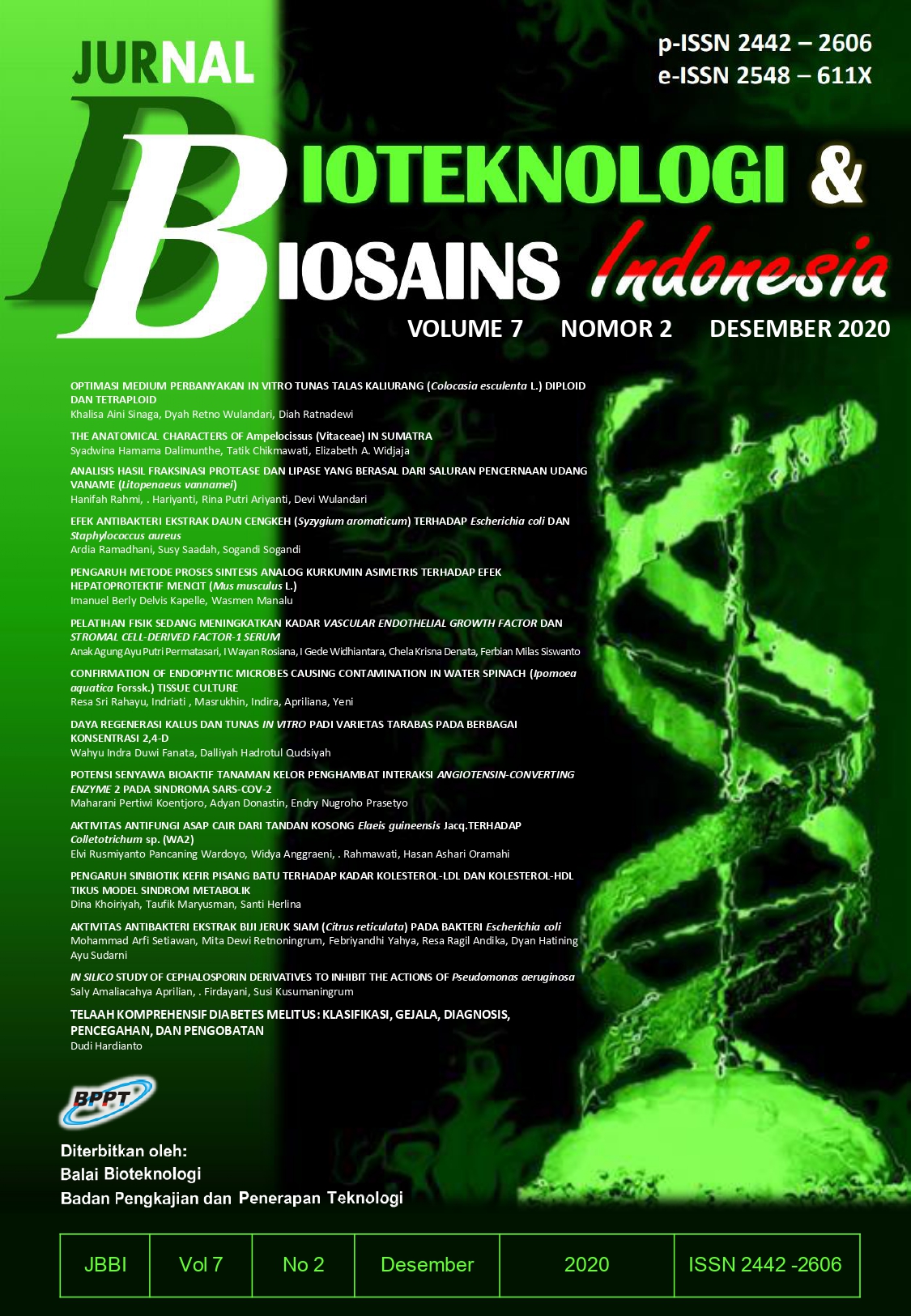PERAN MUTASI GEN ACY II TERHADAP PRODUKSI ANTIBIOTIK SEFALOSPORIN
Main Article Content
Abstract
Antibiotik sefalosporin semisintetik banyak digunakan untuk mengatasi penyakit infeksi, khususnya yang ditimbulkan oleh bakteri gram negatif. Berbagai jenis antibiotik semisintetk dapat disintesis menggunakan senyawa asam 7-aminosefalosporanat (7-ACA) sebagai bahan baku utamanya. Senyawa 7-ACA diperoleh melalui konversi sefalosporin C, baik yang dilakukan secara kimiawi maupun enzimatis. Konversi sefalosporin C menjadi 7-ACA secara enzimatis dalam satu langkah melibatkan enzim sefalosporin asilase. Hingga saat ini, seluruh enzim sefalosporin asilase yang dihasilkan oleh mikroba wild type hanya mempunyai aktifitas yang tinggi terhadap glutaryl-7-ACA. Rekayasa genetik terhadap gen pengkode enzim sefalosporin asilase diperlukan untuk memperoleh enzim rekombinan yang mempunyai aktifitas tinggi terhadap substrat sefalosporin C. Dalam ulasan ini diuraikan upaya-upaya rekayasa yang telah dilakukan terhadap gen acyII dari Pseudomonas SE83 menggunakan teknik mutasi terarah, error prone PCR, dan pemodelan struktur.
Article Details

This work is licensed under a Creative Commons Attribution-NonCommercial-ShareAlike 4.0 International License.
Authors who publish with this journal agree to the following terms:
a). Authors retain copyright and grant the journal right of first publication with the work simultaneously licensed under a Attribution-NonCommercial-ShareAlike 4.0 International that allows others to share the work with an acknowledgement of the work's authorship and initial publication in this journal.
b). Authors are able to enter into separate, additional contractual arrangements for the non-exclusive distribution of the journal's published version of the work (e.g., post it to an institutional repository or publish it in a book), with an acknowledgement of its initial publication in this journal.
c). Authors are permitted and encouraged to post their work online (e.g., in institutional repositories or on their website) prior to and during the submission process, as it can lead to productive exchanges, as well as earlier and greater citation of published work (See The Effect of Open Access).
References
Aramori I, Fukagawa M, Tsumura M, Iwami M, Isogai T, Ono H, Ishitani Y, Kojo H, Kohsaka M, Ueda Y, Imenaka H (1991) Cloning and nucleotide sequencing of new glutaryl 7-ACA and cephalosporin C acylase genes from Pseudomonas strains. J Ferment Bioeng 72:232-243. doi: 10.1016/0922-338X(91)90155-A
Barber MS, Giesecke U, Reichert A, Minas W (2004) Industrial enzymatic production of cephalosporin-based b-lactams. Adv Biochem Engin/ Biotechnol 88:179-216. doi: 10.1007/b99261
Boeckel VTP, Gandra S, Ashok A, Caudron Q, Grenfell BT, Levin SA, Laxminarayan R (2014) Global antibiotic consumption 2000 to 2010: an analysis of national pharmaceutical sales data. Lancet Infect Dis 14:742-750. doi: 10.1016/S1473-3099(14)70780-7
Coates ARM, Halls G, Hu Y (2011) Novel classes of antibiotics or more of the same? Br J Pharmacol 163:184-194. doi: 10.1111/j.1476-5381.2011.01250.x
Gaurav K, Srivastava R, Sharma JG, Kundu S (2015) Statistical medium optimization for the production of cephalosporin-c acylase by Pseudomonas diminuta. J Biochem Technol 6:977-981
Golden E, Paterson R, Tie WJ, Anandan A, Flematti G, Molla G, Rosini E, Pollegioni L, Vrielink A (2013) Structure of a class III engineered cephalosporin acylase: comparisons with class I acylase and implications for differences in substrate specificity and catalytic activity. Biochem J 451: 217-226. doi: 10.1042/BJ20121715
Isdiyono BW, Hardianto D, Ivan FX (2017) Produksi rekombinan sefalosporin asilase sebagai biokatalis untuk produksi asam 7-aminosefalosporanat. J Bioteknol Biosains Indones 4:28-35. doi: 10.29122/jbbi.v4i1.2059
Kim Y, Yoon KH, Khang Y, Turley S, Hol WGJ (2000) The 2.0 Å crystal structure of cephalosporin acylase. Structure 8:1059-1068. doi: 10.1016/S0969-2126(00)00505-0
Li Q, Huang X, Zhu Y (2014) Evaluation of active designs of cephalosporin C acylase by molecular dynamics simulation and molecular docking. J Mol Model 20:2314. doi: 10.1007/s00894-014-2314-5
Mehta D, Sharma AK (2016) Cephalosporins: A review on imperative class of antibiotics. Inventi Rapid: Molecular Pharmacology 1:1-6
Nupura H, Asmita T, Sharath B, Asmita P (2008) Media optimization for the production of cephalosporin C acylase from a novel bacteria source: Alcaligenes xylosoxidans MTCC*491. Res J Biotechnol 3:16-21
Pollegioni L, Lorenzi S, Rosini E, Marcone GL, Molla G, Verga R, Cabri W, Pilone MS (2005) Evolution of an acylase active on cephalosporin C. Protein Sci 14:3064-3076. doi: 10.1110/ps.051671705
Pollegioni L, Rosini E, Molla G (2013) Cephalosporin C acylase: dream and(/or) reality. Appl Microbiol Biotechnol 97:2341-2355. doi: 10.1007/s00253-013-4741-0
Shin YC, Jeon JYJ, Jung KH, Park MR, Kim Y (2009) Cephalosporin C acylase mutant and method for preparing 7-ACA using same. United States Patent No US 7,592,168 B2
Tanomand A, Abeshov R, Farajnia S (2009) Determination of cephalosporin acylase activity by biological and colorimetric method in bacteria. Afr J Biotechnol 8:6697-6699
Vasait RD, Jobanputra AH (2013) Screening, isolation and identification of bacterial isolates having potential for bioconversion of cephalosporin C. Biotechnol India J 7:159-162
Wang Y, Yu H, Song W, An M, Zhang J, Luo H, Shen Z (2012) Overexpression of synthesized cephalosporin C acylase containing mutations in the substrate transport tunnel. J Biosci Bioeng 113:36-41. doi: 10.1016/j.jbiosc.2011.08.027
World Health Organization (2017) Critically important antimicrobials for human medicine. 5th rev. Geneva. Licence: CC BY-NC-SA 3.0 IGO
Xiao Y, Huo X, Qian Y, Zhang Y, Chen G, Ouyang P, Lin Z (2014) Engineering of CPC acylase using a facile pH indicator assay. J Ind Microbiol Biotechnol 41:1617-1625. doi: 10.1007/s10295-014-1501-9
Yu R (2013) Modeling and experimental analysis of cephalosporin C acylase and its mutant. Open Biotechnol J 7:30-37. doi: 10.2174/1874070701307010030
Zhang J, Yu H, Wang Y, Luo H, Shen Z (2014) Determination of the second autoproteolytic cleavage site of cephalosporin C acylase and the effect of deleting its flanking residues in the α-C-terminal region. J Biotechnol 184:138-145. doi: 10.1016/j.jbiotec.2014.05.016
